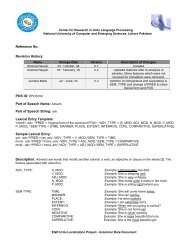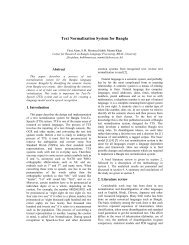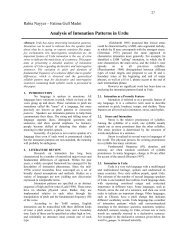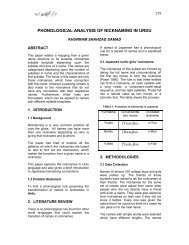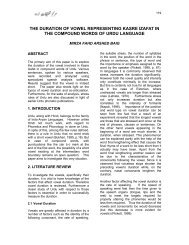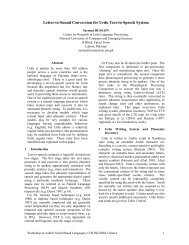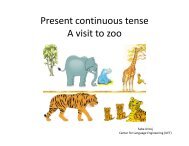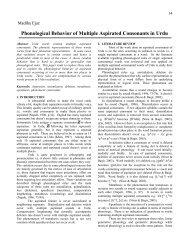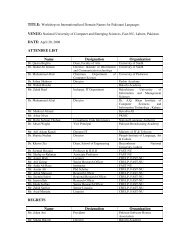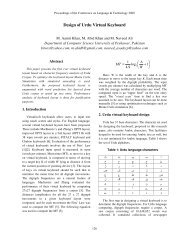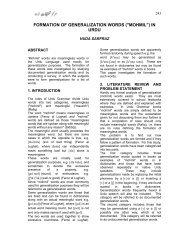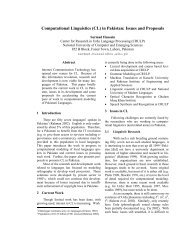Corpus Based Urdu Lexicon Development
Corpus Based Urdu Lexicon Development
Corpus Based Urdu Lexicon Development
Create successful ePaper yourself
Turn your PDF publications into a flip-book with our unique Google optimized e-Paper software.
<strong>Corpus</strong> <strong>Based</strong> <strong>Urdu</strong> <strong>Lexicon</strong> <strong>Development</strong><br />
Madiha Ijaz<br />
Centre for Research in <strong>Urdu</strong> Language Processing<br />
National University of Computer and Emerging Sciences<br />
madiha.ijaz@nu.edu.pk<br />
Sarmad Hussain<br />
Centre for Research in <strong>Urdu</strong> Language Processing<br />
National University of Computer and Emerging Sciences<br />
sarmad.hussain@nu.edu.pk<br />
Abstract<br />
The paper discusses various phases in <strong>Urdu</strong> lexicon<br />
development from corpus. First the issues related with<br />
<strong>Urdu</strong> orthography such as optional vocalic content,<br />
Unicode variations, name recognition, spelling<br />
variation etc. have been described, then corpus<br />
acquisition, corpus cleaning, tokenization etc has been<br />
discussed and finally <strong>Urdu</strong> lexicon development i.e.<br />
POS tags, features, lemmas, phonemic transcription and<br />
the format of the lexicon has been discussed .<br />
1. Introduction<br />
The project focuses on the creation of an <strong>Urdu</strong><br />
lexicon needed for speech-to-speech translation<br />
components i.e. flexible vocabulary speech recognition,<br />
high quality text-to-speech synthesis and speech<br />
centered translation following the guidelines of LC-<br />
STAR II (http://www.lc-star.org/).<br />
A broad range of common domains and domains for<br />
proper names was chosen to be collected from<br />
electronically available resources and print media as<br />
well. A corpus of 19.3 million was collected and then a<br />
large lexicon was created based on that corpus listing<br />
detailed grammatical, morphological, and phonetic<br />
information suited for flexible vocabulary speech<br />
recognition and high quality speech synthesis.<br />
This paper deals with issues regarding <strong>Urdu</strong><br />
orthography, corpus development (e.g. corpus<br />
acquisition, pre-processing, tokenization, cleaning e.g.<br />
typos, name recognition etc) and then finally lexicon<br />
development for common words.<br />
2. <strong>Urdu</strong> Orthography<br />
<strong>Urdu</strong> is written in Arabic script in Nastaleeq style<br />
using an extended Arabic character set. The character<br />
set includes basic and secondary letters, aerab (or<br />
diacritical marks), punctuation marks and special<br />
symbols [1]. <strong>Urdu</strong> support in Unicode is given in Arabic<br />
Script block. Further details regarding <strong>Urdu</strong> letters,<br />
diacritics, numbers, special symbols and Unicode<br />
variation are described ahead.<br />
<strong>Urdu</strong> text comprises of the alphabets as show in<br />
Figure 1. [9].<br />
Figure 1: <strong>Urdu</strong> alphabet<br />
Diacritics described in Table 1 exist in <strong>Urdu</strong> text [10,<br />
11].<br />
Diacritic<br />
Zabar (Fatah)<br />
Fatah Majhool<br />
Zair (Kasra)<br />
Kasra Majhool<br />
Paish (Zamma)<br />
Zamma Majhool<br />
Sakoon (Jazm)<br />
Tashdeed (Shad)<br />
Tanween<br />
Khara Zabar<br />
Elaamat-e-<br />
Ghunna<br />
ã ث ã ٹ ã ث ج ã چ<br />
Symbol<br />
(Unicode)<br />
Table 1: Diacritics in <strong>Urdu</strong><br />
Example<br />
اآ ب ã پ<br />
دھ ڈ ڈھ<br />
ذر رھ ڑ ڑھ ز<br />
ã ح خ د<br />
IPA<br />
( E064) َ لَب ləb<br />
( E064) َ زَہر zɛhɛr<br />
d̪ɪl دِل ِ 0650) (<br />
ِ 0650) (<br />
اِہتِمام eh.t̪e.mɑm ( F064) ُ کُل gʊl<br />
( F064) ُ عُہدہ oh.d̪ɑ<br />
səbz سبْزْ ْ 0652) (<br />
ٰ<br />
ّ 0651) (<br />
ڈبّا ɖəb.bɑ ( B064) ً فوراً fɔ.rən<br />
0670) (<br />
عيسٰی i.sɑ 0658) (<br />
جنگ ʤəŋ Digits from 0 to 9 are represented in <strong>Urdu</strong> are shown<br />
in Figure 2.<br />
س شصضط ظ ع غ فژ<br />
ق ک ãD گ ã ل ã م ã ن<br />
ã<br />
<br />
ã ے ہ ء ی ؤھ ؤ ں<br />
1
Figure 2: <strong>Urdu</strong> digits<br />
Special symbols that may occur in <strong>Urdu</strong> text are<br />
shown in Figure 3. Their details can be found in Arabic<br />
script block in Unicode<br />
(http://www.unicode.org/charts/).<br />
Figure 3: <strong>Urdu</strong> special symbols<br />
The following sections discuss some issues that arise<br />
due to Unicode and <strong>Urdu</strong> orthography.<br />
2.1. Unicode Variations<br />
The Unicode standard provides almost complete<br />
support for <strong>Urdu</strong>. However, there are a few<br />
discrepancies, for example in Unicode, the character<br />
Hamza (ء) is declared a non-joiner (i.e. it does not<br />
connect with the letter following it). However, in <strong>Urdu</strong><br />
language words e.g., قائل / kɑ.ɪl / require a Hamza to be<br />
joined with the characters following it. For such words<br />
Unicode provides a separate character ئ (joining<br />
Hamza) instead of .ء Similarly, the character Bari Yay<br />
is also considered a non-joiner in Unicode (with the (ے)<br />
following character), but the word بے کار /be.kɑr/<br />
(adjective: “useless”). is also commonly written in <strong>Urdu</strong><br />
ی /be.kɑr/. To write the latter, we need to put بيکار as<br />
instead of ے so that the Yay joins with Kaaf .ک These<br />
issues still need to be resolved with the Unicode<br />
standard for complete <strong>Urdu</strong> support.<br />
Some characters like ک، ہ، ی، etc. have more than<br />
one Unicode value in different keyboards. Such<br />
characters are replaced by one standard character<br />
(depending on their position within the word) in order to<br />
normalize them before any processing is done on them.<br />
Appendix A provides the currently handled characters<br />
for normalization.<br />
2.2. Optional vocalic content<br />
<strong>Urdu</strong> is normally written only with letters, diacritics<br />
being optional. However, the letters represent just the<br />
consonantal content of the string and in some cases<br />
(under-specified) vocalic content. The vocalic content<br />
may be optionally or completely specified by using<br />
diacritics with the letters [1]. Every word has a correct<br />
set of diacritics, however, it can be written with or with<br />
out any diacritics at all, therefore, completely or<br />
partially omitting the diacritics of a word is permitted.<br />
In certain cases, two different words (with different<br />
pronunciations) may have exactly the same form if the<br />
diacritics are removed, but even in that case writing<br />
words without diacritics is permitted. One such example<br />
is given below:<br />
(swim) /t̪ær/ تَير<br />
/t̪ir/ (arrow)<br />
However, there are exceptions to this general<br />
behavior, certain words in <strong>Urdu</strong> require minimal<br />
diacritics without which they are considered incomplete<br />
and cannot be correctly read or pronounced. Some of<br />
these words are shown in Table 2.<br />
تِير<br />
Actual word<br />
/ɑ.lɑ/<br />
English<br />
translation<br />
High quality<br />
With<br />
diacritics<br />
(correct)<br />
اعلٰی<br />
/ɑ.lɑ/<br />
Without<br />
diacritics<br />
(incorrect)<br />
اعلی<br />
/ɑ.li/<br />
تقريبا<br />
تقريباً<br />
۔<br />
۰ ۱ ۲ ۳ ۴ ۵ ۶ ۷ ۸ ۹<br />
٪<br />
/t̪əq.ri.bən/<br />
almost<br />
/t̪əq.ri.bən/<br />
/t̪əq.ri.bɑ/<br />
Table 2: Some <strong>Urdu</strong> words that require<br />
diacritics<br />
2.3. Proper name identification and spelling<br />
variation<br />
In <strong>Urdu</strong>, there is no concept of capitalization. Proper<br />
names cannot be identified through script analysis and<br />
there is no ‘<strong>Urdu</strong> specific’ algorithm for named entity<br />
tagging.<br />
Spelling variations are quite common in <strong>Urdu</strong>. The<br />
main reason for these variations is that there are many<br />
homophone characters (different letters representing the<br />
same phoneme) in <strong>Urdu</strong>. Also people tend to confuse<br />
different homophones for each other, so, as a result,<br />
incorrect spelling of words having homophones<br />
becomes quite common. For example, ”ز“ and ”ذ“ are<br />
homophone characters and are very frequently confused<br />
with each other. The word ”پذير“ /pə.zir/ is commonly<br />
written in news papers, books and some dictionaries<br />
with letter ”ز“ instead of ,”ذ“ which is correct.<br />
<strong>Urdu</strong> collation sequence is fully standardized. In<br />
<strong>Urdu</strong>, three levels of sorting are required for letters,<br />
2
diacritics and special symbols. The complete table of<br />
collation element of <strong>Urdu</strong> is given in [8].<br />
3. <strong>Urdu</strong> <strong>Corpus</strong> development<br />
A large amount of text is needed in order to build the<br />
corpus which is used for lexicon extraction.<br />
Electronically available resources are the most suitable<br />
for collection of text but unfortunately it is not easy to<br />
collect <strong>Urdu</strong> text as first of all there is no publicly<br />
available large amount of <strong>Urdu</strong> text and secondly most<br />
of the websites containing <strong>Urdu</strong> text display it in<br />
graphics i.e. gif format which makes it unfit to be used<br />
in any text based application [5, 6].<br />
3.1. <strong>Corpus</strong> acquisition<br />
The data was gathered from a broad range of<br />
domains mentioned in Table 3 keeping in view the end<br />
user perspective.<br />
Domains<br />
Sub domains<br />
C1. Sports/Games C1.1.Sports (special events)<br />
C2. News C2.1. Local and international<br />
affairs<br />
C2.2. Editorials and opinions<br />
C3. Finance C3.1. Business, domestic and<br />
foreign market<br />
C4. Culture/Entertainment C4.1. Music, theatre,<br />
exhibitions, review articles on<br />
literature<br />
C4.2. Travel / tourism<br />
C5. Consumer Information C5.1. Health<br />
C5.2. Popular science<br />
C5.3. Consumer technology<br />
C6. Personal communications C6.1. Emails, online<br />
discussions, editorials, e-zines<br />
Table 3: <strong>Corpus</strong> domains<br />
It was ensured while collecting text from the above<br />
mentioned domains that [14]<br />
1. Each domain was represented by at least 1<br />
million tokens.<br />
2. The cut-off date for all corpora used was 1990<br />
as it has been shown that corpora structure and<br />
time of appearance of corpora has a large<br />
impact on the extracted word lists.<br />
3. Data from chat rooms was not included<br />
Text was collected from two news websites i.e. Jang<br />
(www.jang.com.pk) and BBC<br />
(http://www.bbc.co.uk/urdu/) and it was made sure that<br />
the data collected was not older than 2002.<br />
Apart from the news websites text was also collected<br />
from books and magazines related to required domains<br />
and the data collected from these sources was not older<br />
than 1990.<br />
3.2. Pre-processing<br />
Data that was gathered had different character<br />
encoding schemes and before doing any further<br />
processing it was to be converted to a standard character<br />
encoding scheme i.e. UTF-16.<br />
Data gathered from news websites was in HTML<br />
format so it was converted to UTF-16. Similarly data<br />
gathered from magazines was in inpage format and<br />
hence it was also converted to UTF-16.<br />
3.3. Tokenization<br />
For the development of <strong>Urdu</strong> lexicon, words are<br />
derived from the corpus by assuming white spaces (tab,<br />
space character, carriage return and linefeed) and<br />
punctuation marks (hyphen, semicolon, backslash, caret,<br />
vertical line, Arabic ornamental left parenthesis and<br />
right parenthesis, comma, apostrophe, exclamation<br />
mark, Arabic semicolon, colon, quotation mark, Arabic<br />
starting and ending quotes, Arabic question mark),<br />
special symbols (dollar, percent, ampersand, asterisk,<br />
plus), digits (0-9 and ٠-٩) and English alphabets (A-Z<br />
خوش “ like and a-z) as word boundaries. Thus words<br />
/xʊʃ.mɪ.zɑʤ/ (adjective: “pleasant”), erroneously ”مزاج<br />
get split into two separate words ”خوش“ /xʊʃ/ (adjective:<br />
“happy”) and ”مزاج“ /mɪ.zɑʤ/ (noun: “temperament”).<br />
Also words like داری“ ”ذمہ /zɪm.mɑ.d̪ɑ.ri/ (noun:<br />
”ذمہ“ “responsibility”) erroneously get split into<br />
/zɪm.mɑ/ (noun: “responsibility”) and ”داری“ /d̪ɑ.ri/<br />
(non-word suffix) [13]. In order to cater to words like<br />
the tokenizer was modified and a list of ”ذمہ داری“<br />
prefixes and suffixes was used to determine that<br />
whether the token under consideration is an affix or not<br />
and if it was an affix then depending on whether it is<br />
prefix or suffix, the tokenizer picked the next and<br />
previous word respectively e.g. ”داری“ is a suffix so in<br />
this case it picked the previous word etc.<br />
Description of procedure of word list extraction is as<br />
follow<br />
• The Html and Inpage files were converted to<br />
Unicode text files (UTF-16).<br />
• The text in those files was tokenized on<br />
characters like white space, punctuation marks,<br />
special symbols etc.<br />
• Some characters like ک، ہ، ی، etc. have more<br />
than one Unicode values in different<br />
keyboards. Such characters were replaced by<br />
3
one standard character (depending on their<br />
position within the word) in order to normalize<br />
them before any processing was done on them.<br />
• Diacritics were removed from the word list e.g.<br />
/t̪ir/ (arrow) were both تِير /t̪ær/ (swim) and تَير<br />
.تير mapped to<br />
• Word frequencies were updated.<br />
• The tokenization based on space does not<br />
completely identify the words from the corpus<br />
correctly. The output needs to be reviewed in<br />
order to remove non-words which may occur<br />
due to erroneous output of tokenizer or due to<br />
typing errors. Proper names, typos etc were<br />
removed from the word list manually and the<br />
words that were written without space were<br />
separated (space insertion problem) e.g. the<br />
طاہر words, comprises of four طاہرکوکهلاد يا token<br />
/t̪a.h ɪ r/ (proper name and an adjective), کو /ko/<br />
(case marker), کهلا / kʰ ɪ .la/ (verb) and ديا / d̪ ɪ<br />
.ja/ (verb). Word frequencies were updated<br />
after space insertion.<br />
When non-words were analyzed, it was revealed that<br />
most of them were affixes apart from proper names and<br />
typos. Hence a list of valid <strong>Urdu</strong> affixes was developed<br />
and tokenizer was modified to pick next or previous<br />
word if it encountered a prefix or suffix respectively and<br />
”ذمہ داری“ e.g. frequencies were adjusted accordingly<br />
/zɪm.mɑ.d̪ɑ.ri/ (noun: “responsibility”) is a word with<br />
affix "داری" if its frequency was 10 then 10 was<br />
subtracted from the frequency of " "ذمہ and from the<br />
frequency of داری" " as well.<br />
4. <strong>Urdu</strong> <strong>Lexicon</strong> <strong>Development</strong><br />
<strong>Urdu</strong> lexicon development involved decisions<br />
regarding part-of-speech tags and their respective<br />
features, lemmas, transcription and lexicon format.<br />
4.1. POS tags<br />
Since the lexicon is to be used for speech-to-speech<br />
translation components, a high-level POS tag set<br />
covering main categories is adequate.<br />
POS tags decided for <strong>Urdu</strong> lexicon development are<br />
as follow<br />
1. Noun.<br />
2. Verb.<br />
3. Adjective.<br />
4. Adverb.<br />
5. Numerals.<br />
6. Post positions.<br />
7. Conjunctions.<br />
8. Pronouns<br />
9. Auxiliaries.<br />
10. Case marker.<br />
11. Harf.<br />
All the recognizable POS tags of the word were<br />
identified, regardless of the context in which the word is<br />
used in the corpus. The details of the POS tags are given<br />
in Appendix B.<br />
Two of the above listed POS are particular to <strong>Urdu</strong>.<br />
Their details are given below:<br />
4.1.1 Harf: Harf is a word which is not meaningful<br />
unless used with other words to give meaning [10]. This<br />
واہ ho/, /o اوہو /æ/, ےا category includes words like<br />
/vɑ/, پر /pər/ etc.<br />
4.1.2 Case markers: Case markers are a special word<br />
class in <strong>Urdu</strong>. In some languages case marking is a<br />
morphological process, but in <strong>Urdu</strong> case markers are<br />
written with a space. Therefore they are considered as a<br />
separate word and are assigned a separate POS tag.<br />
There are mainly three case markers: ergative, نے /ne/,<br />
dative/accusative, کو /ko/ and genitive, کا /ka/.<br />
Sometimes سے /se/ is also included in this category as<br />
being an instrumentative case marker. Some<br />
grammarians [10] consider case markers as a subset of<br />
Haroof 1 , but due to their distinct role of case marking<br />
(agent/patient role etc), it is better to separate them from<br />
other Haroof.<br />
<strong>Urdu</strong> lexicon does not include respect feature. It also<br />
does not include separate POS tag for the light verb and<br />
aspectual auxiliary because both light verbs and<br />
aspectual auxiliaries have the same surface forms as a<br />
verb in the language. Once the wordlists are prepared<br />
from the corpus the context of the word is lost. In order<br />
to identify a word as a light verb or aspectual auxiliary it<br />
is essential to know whether it occurred in the corpus in<br />
combination with some other word or as an independent<br />
verb.<br />
4.2. Lemmas<br />
Lemma is a canonical form of a word. Morphological<br />
forms considered as lemma according to well-known<br />
guidelines of <strong>Urdu</strong> are the following:<br />
1. Common noun: singular, nominative with no<br />
respect<br />
1 Plural of Harf<br />
4
يا<br />
2. Verb: masculine, singular, nominative,<br />
infinitive<br />
3. Adjective: masculine, singular, nominative if<br />
the word ends at vowel otherwise the word<br />
itself.<br />
4. Adverb: usually same as the word itself<br />
5. Numeral: in case of cardinal it is same as the<br />
word but in case of ordinal it is masculine,<br />
singular, nominative.<br />
6. Post-position (ad positions): same as the word<br />
itself<br />
7. Conjunction: same as the word itself<br />
8. Pronoun: masculine, singular, nominative if the<br />
word ends at vowel otherwise the word itself.<br />
9. Auxiliary verb: masculine, singular,<br />
nominative, infinitive<br />
10. Case marker: same as the word itself except the<br />
genitive case markers, in that case it is<br />
masculine, singular, nominative.<br />
11. Harf: same as the word itself<br />
4.3. Phonemic Transcription<br />
<strong>Urdu</strong> phonemic inventory consists of 44 consonants,<br />
8 long oral vowels, 7 long nasal vowels, 3 short vowels<br />
and numerous diphthongs (set of <strong>Urdu</strong> diphthongs is<br />
still under analysis). This phonemic inventory is<br />
presented in Table 4 [3]. The italicized phonemes are<br />
those whose existence is still controversial. These are<br />
mainly aspirated versions of nasal stops, lateral and<br />
retroflex. Different studies conducted at CRULP to<br />
explore the existence of these aspirated phonemes show<br />
that they were once part of the <strong>Urdu</strong> phonemic<br />
inventory and are now either already extinct or slowly<br />
dying out [4].<br />
Table 4: <strong>Urdu</strong> Phonemic Inventory [1]<br />
Letter to sound rules are mostly regular. Consonantal<br />
letters have a one-to-one mapping with consonantal<br />
sounds. There are no letter-clusters to single phoneme<br />
mappings as in case of English (ph for example). The<br />
mapping of diacritics and some basic letters to vocalic<br />
sounds is generally determined by their context. For a<br />
detailed discussion on ‘grapheme to phoneme mapping<br />
rules’, refer to “Letter to Sound Rules for <strong>Urdu</strong> Text to<br />
Speech System” [1].<br />
<strong>Based</strong> on the results of Wells [12] and Hussain [1],<br />
the table given in Appendix C was derived and used for<br />
<strong>Urdu</strong> lexicon development. It shows the mapping of<br />
<strong>Urdu</strong> letters to IPA [1] and the mapping of that<br />
respective IPA to SAMPA [12].<br />
4.4. <strong>Lexicon</strong> Format<br />
The XML format given in LC-STAR D2.1 document<br />
[7] was followed. A sample containing some of the<br />
lexicon entries is given below<br />
<br />
5. Results<br />
Domain wise corpus size distribution is given<br />
in Table 5.<br />
Raw Corpora<br />
Domains<br />
Distinct<br />
Size<br />
words<br />
C1. Sports/Games 1,666,304 23,118<br />
C2. News 8,957,259 67,365<br />
C3. Finance 1,162,019 17,024<br />
C4. Culture/Entertainment 3,845,117 59,214<br />
C5. Consumer Information 1,980,723 34,151<br />
C6. Personal<br />
30,469<br />
communications 1,685,424<br />
Total 19,296,846 104,341<br />
Table 5: Domain wise corpus size distribution<br />
(raw)<br />
The big difference in total number of words and<br />
unique words shows that closed class words are used<br />
extensively in written <strong>Urdu</strong> text [2] which is also<br />
apparent from the 100 high frequency words given in<br />
Appendix D.<br />
Domain wise corpus size distribution after cleaning<br />
is given in Table 6.<br />
Clean Corpora<br />
Domains<br />
Distinct<br />
Size<br />
Words<br />
C1. Sports/Games 1,529,066 15,354<br />
C2. News 8,425,990 36,009<br />
C3. Finance 1,123,787 13,349<br />
C4. Culture/Entertainment 3,667,688 34,221<br />
C5. Consumer Information 1,929,732 24,722<br />
C6. Personal<br />
1,632,353 23,409<br />
communications<br />
Total 18,308,616 50,365<br />
Table 6: Domain wise corpus size distribution<br />
(clean)<br />
Hence a total of 50,365 words were obtained from a<br />
corpus of 19.3 million that had 104,341<br />
orthographically unique words.<br />
The difference in the number of words in the raw<br />
corpus and the clean corpus is due to the fact that proper<br />
names and typos were removed from the wordlist and in<br />
case of spelling variations only standard orthography of<br />
a word was kept and rest were discarded.<br />
6. Conclusion<br />
Various stages for lexicon development from corpus<br />
have been discussed in this paper. Also the approaches<br />
followed in those stages have been described and among<br />
which two of these approaches need further exploration<br />
and consideration.<br />
First, there are issues of space insertion and deletion<br />
in <strong>Urdu</strong> text so the word boundary detection in <strong>Urdu</strong><br />
requires a more sophisticated algorithm than simple<br />
tokenization on spaces.<br />
Secondly, once the wordlists are prepared from the<br />
corpus the context of the word is lost and context is<br />
most of the time very important in determining the POS<br />
and actual pronunciation of a word e.g. سونا /so.na/<br />
could be the verb "to sleep", noun "gold" and adjective<br />
"deserted", so while determining POS and pronunciation<br />
context should be considered. Hence some other<br />
approach should be developed and instead of losing<br />
context, it should be kept and in this way the lexicon<br />
developed will contain the recent and frequent usage of<br />
a word not the old or deprecated one.<br />
References<br />
[1] S. Hussain, "Letter to Sound Rules for <strong>Urdu</strong> Text to<br />
Speech System", in Proceedings of Workshop on<br />
Computational Approaches to Arabic Script-based Languages,<br />
COLING 2004, Geneva, Switzerland (2004).<br />
[2] Humayoun, "<strong>Urdu</strong> morphology, orthography and lexicon<br />
extraction", master's thesis, Chalmers University of<br />
Technology, Sweden, 2006.<br />
[3] H. Kabir, A. M. Saleem, "Speech Assessment Methods<br />
Phonetic Alphabet (SAMPA): Analysis of <strong>Urdu</strong>". CRULP<br />
Annual Student Report published in Akhbar-e-<strong>Urdu</strong>, April-<br />
May 2002, National Language Authority, Islamabad, Pakistan.<br />
[4] A. M. Saleem, H. Kabir, M.K. Riaz, M.M. Rafique, N.<br />
Khalid, and S.R. Shahid. "<strong>Urdu</strong> Consonantal and Vocalic<br />
Sounds". CRULP Annual Student Report published in Akhbare-<strong>Urdu</strong>,<br />
April-May 2002, National Language Authority,<br />
Islamabad, Pakistan.<br />
[5] Riaz and Becker, "A study in <strong>Urdu</strong> corpus construction".<br />
The 3rd Workshop on Asian Language Resources and<br />
International Standardization, COLING 2002.<br />
[6] Baker, JP, Hardie, A, McEnery, AM and Jayaram, BD<br />
(2003) "<strong>Corpus</strong> data for South Asian language processing." In:<br />
Proceedings of the EACL Workshop on South Asian<br />
Languages, Budapest<br />
6
[7] Giulio Maltese, Chiara Montecchio (IBM), LC-STAR<br />
Deliverables D2.1, Post final version May 2004<br />
(http://www.lc-star.org/).<br />
[8] S. Hussain et. al. "<strong>Urdu</strong> Encoding and Collation Sequence<br />
for Localization", 2004.<br />
[9] National Language Authority (Cabinet Division),<br />
Government of Pakistan (www.nla.gov.pk)<br />
[10] Maulvi Abdul Haq, قوائد اردو (Qawaid-i-<strong>Urdu</strong>), Lahore<br />
Academy, Pakistan.<br />
[11] <strong>Urdu</strong> Lughat, Taraqqi, <strong>Urdu</strong> Board Karachi, Pakistan.<br />
[12] Wells, J.C., "Computer-coding the IPA: a proposed<br />
extension of SAMPA", University College, London, 1995<br />
(www.phon.ucl.ac.uk/home/sampa/x-sampa.htm)<br />
[13] Hardie, "The computational analysis of morphosyntactic<br />
categories in <strong>Urdu</strong>", PhD. thesis, Lancaster, 2003.<br />
[14] Ziegenhein, U., et al. (2003): “Specification of corpora<br />
and word lists in 12 languages”, LC-Star deliverable D1.1<br />
(http://www.lc-star.org/).<br />
7
Appendix A<br />
Standard characters<br />
Character with<br />
variation Start position<br />
Intermediary<br />
position End position<br />
( U0647) ه U06BE) (<br />
ه U06BE) ( ہ (U06C1) ه<br />
( U06D5) ہ U06C1) (<br />
ہ U06C1) ( ہ (U06C1) ( U0629) ة U06C3) (<br />
ة U06C3) ( ة (U06C3) ە<br />
ة<br />
ی (U06CC) ی U06CC) ( ی U06CC) ( U0649) (<br />
ى<br />
( U064A) ی U06CC) (<br />
ی U06CC) ( ی (U06CC) ( U061F) ( U003F) ( U003F) (U003F) <br />
( U066D) ( U002A) * ( U002A) * (U002A) *<br />
ي<br />
؟<br />
٭<br />
آ<br />
( U0627+U0653) آ U0622) (<br />
آ U0622) ( آ (U0622) (U06D3)<br />
ۓ<br />
U0654+U06D2)<br />
(<br />
ۓ<br />
ؤ<br />
ئے<br />
U06D2+U0626)<br />
(<br />
ئے<br />
U06D2+U0626)<br />
(<br />
ئے<br />
U06D2+U0626)<br />
(<br />
ئے<br />
U06D2+U0626)<br />
(<br />
ئے<br />
U06D2+U0626)<br />
(<br />
ئے<br />
U06D2+U0626)<br />
(<br />
ؤ (U0624) ؤ U0624) ( ؤ U0624) ( U0648+U0654) (<br />
أ<br />
( U0627+U0654) أ U0623) (<br />
أ U0623) ( أ (U0623) ۂ<br />
U06C1+U0654)<br />
(<br />
ۀ U06C2) ( ۀ U06C2) ( ۀ (U06C2) 8
Appendix B<br />
POS Features Possible values<br />
Verb (VER) Number singular, plural, invariant<br />
Gender Masculine, feminine,<br />
invariant<br />
Person 1, 2, 3, not_1, invariant<br />
Case nominative, oblique,<br />
vocative, invariant<br />
Adjective (ADJ) Gender Masculine, feminine,<br />
invariant<br />
Number singular, plural, invariant<br />
Case nominative, oblique,<br />
vocative, invariant<br />
Common Noun Class common<br />
(NOM)<br />
Gender masculine, feminine,<br />
invariant<br />
Number singular, plural, invariant<br />
Case nominative, oblique,<br />
vocative, invariant<br />
Adverb (ADV) None<br />
Numeral (NUM) Gender masculine, feminine,<br />
invariant<br />
Number singular, plural, invariant<br />
Case nominative, oblique,<br />
vocative, invariant<br />
Type Cardinal, ordinal, ratio<br />
Conjunction<br />
(CON)<br />
Type Subordinating,<br />
coordinating<br />
Auxiliary (AUX) Number singular, plural, invariant<br />
Gender Masculine, feminine,<br />
invariant<br />
Post-positions None<br />
(ADP)<br />
Case Markers<br />
(CM)<br />
Case Ergative, instrumental,<br />
dative/accusative, genitive<br />
Gender masculine, feminine,<br />
invariant<br />
Number singular, plural, invariant<br />
Harf (HAR) None<br />
Pronoun (PRO) Gender masculine, feminine,<br />
invariant<br />
Number singular, plural, invariant<br />
Case nominative, oblique,<br />
dative, accusative,<br />
genitive, invariant<br />
Type personal, demonstrative,<br />
indefinite, interrogative,<br />
relative<br />
9
Appendix C<br />
<strong>Urdu</strong> IPA SAMPA<br />
Consonants<br />
p p پ<br />
b b ب<br />
pʰ p_h په<br />
bʰ b_h به<br />
m m م<br />
mʰ m_h مه<br />
t̪ t_d ت , ط<br />
t̪ʰ t_d_h ته<br />
d̪ d_d د<br />
d̪ʰ d_d_h ده<br />
n n ن<br />
nʰ n_h نه<br />
Ŋ N نگ<br />
t' ʈ ٹ<br />
d' ɖ ڈ<br />
ʈʰ t'_h ٹه<br />
ɖʰ d'_h ڈه<br />
k k ک<br />
g g گ<br />
kʰ k_h که<br />
gʰ g_h گه<br />
q q ق<br />
ʔ ع<br />
f f ف<br />
v v و<br />
s s س, ص , ث<br />
z z ذ, ض, ظ, ز<br />
ʃ S ش<br />
ʒ Z ژ<br />
ɣ 7 غ<br />
x x خ<br />
h h ہ ، ح<br />
ʧ t_S چ<br />
ʧʰ t_S_h چه<br />
ʤ d_Z ج<br />
ʤʰ d_Z_h جه<br />
r r ر<br />
10
ʰ r_h ره<br />
r' ɽ ڑ<br />
ɽʰ r'_h ڑه<br />
j j ی<br />
l l ل<br />
lʰ l_h له<br />
vʰ v_h وه<br />
jʰ j_h يه<br />
Vowels<br />
i i ی<br />
e e ے<br />
{ æ َے<br />
u u وُ<br />
o o و<br />
ɔ O وَ<br />
ɑ A ا ، آ<br />
ِ ɪ I<br />
ɛ<br />
E<br />
ُ ʊ U<br />
@ ə َ ، ء<br />
i~ ĩ ںيِ<br />
e~ ẽ يں<br />
{~ æ̃ ںيَ<br />
u~ ũ ُوں<br />
o~ õ وں<br />
اں<br />
ɑ̃<br />
A~<br />
O~ ɔ̃ َوں<br />
Special symbols<br />
Syllable<br />
boundar<br />
y<br />
Stress<br />
marker<br />
Word<br />
boundar<br />
y<br />
. -<br />
’ "<br />
# #<br />
11
Appendix D<br />
100 high frequency words are given below<br />
Word<br />
Frequenc<br />
y<br />
Word<br />
Frequenc<br />
y<br />
Word<br />
Frequenc<br />
y<br />
Word<br />
Frequenc<br />
y<br />
کے<br />
743949 تها 61762 گے 36725 ہوا 27535 27265 دی 34818 کرتے 61090 کہا 582882 ميں<br />
26341 ہوتا 34212 ہونے 57360 گيا 575545 کی<br />
26218 کام 34143 گئے 57041 جو 466908 ہے<br />
25881 حاصل 33693 اپنی 56038 و 413788 اور<br />
25044 رہی 33589 والے 49586 گا 368155 سے<br />
24486 سب 33424 وقت 48594 ہی 306103 کا<br />
24242 کرنا 33032 بہت 47470 جائے 281922 کو<br />
24185 جاتا 32246 کسی 46989 نہ 254385 نے<br />
24102 ہر 32228 جا 46894 جب 244017 اس<br />
23927 سی 31627 تهی 46829 اپنے 237419 کہ<br />
22284 طور 31361 يا 46299 آپ 217948 ہيں<br />
21801 خان 31279 گئی 45733 جس 207921 پر<br />
21641 پہلے 30962 ہم 45394 ديا 173407 کر<br />
21568 کچه 30623 ہوں 43418 تهے 145669 ہو<br />
21425 صرف 30164 کيلئے 42427 ہوئے 140157 بهی<br />
20853 انہيں 29541 زيادہ 42422 تک 129851 ايک<br />
20564 سال 29528 ملک 40860 بعد 128103 يہ<br />
20301 وجہ 29415 بات 39903 انہوں 115341 نہيں<br />
20261 کم 29272 رہا 39784 رہے 110463 ان<br />
20095 جنگ 28965 طرح 38807 ساته 108414 کيا<br />
19942 اسے 28729 اگر 38482 ليکن 88137 تو<br />
19935 ہوتی 28345 اب 37533 گی 83613 وہ<br />
19820 ليے 28332 حکومت 37351 کريں 66765 لئے<br />
19654 ٹيم 28236 دو 36801 کوئی 64589 کرنے<br />
12


